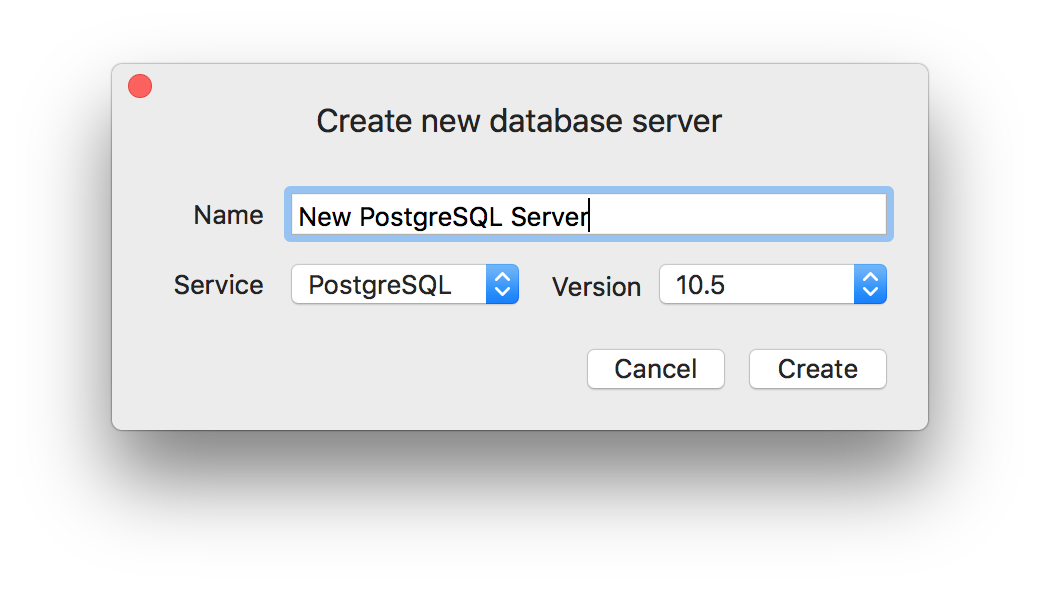

- INSTALL POSTGRES ON MAC AND USE TABLEPLUS MAC OS
- INSTALL POSTGRES ON MAC AND USE TABLEPLUS INSTALL
- INSTALL POSTGRES ON MAC AND USE TABLEPLUS MANUAL
- INSTALL POSTGRES ON MAC AND USE TABLEPLUS SOFTWARE
INSTALL POSTGRES ON MAC AND USE TABLEPLUS MANUAL
Featuresįor the installation, you can use the automatic, manual or offline installation. There are two versions: Community Edition or Enterprise Edition. It also allows you to promote masters and rebuild slaves. The automation features inside ClusterControl let you easily setup a PostgreSQL replication environment, where you can add new replication slaves from scratch or use ones that are already configured. You can manage backups, run queries, and perform advanced monitoring of all the master and slaves all with automated failover if something goes wrong. ClusterControlĬlusterControl supports deployment, management, monitoring and scaling for PostgreSQL.Įach deployed PostgreSQL instance is automatically configured using ClusterControl’s easy to use point-and-click interface. The installation requires adding a repository, so it could require some additional skills. The charts in the main screen could help to detect some issue on your system. The design looks good and it’s an intuitive interface. After the program is running, you can manage your database from a web interface accessing by the pgAdmin icon on the taskbar. This port changes every time you run the pgadmin4 command.

The installation creates a pgAdmin server listening in a specific port. Then, you only need to run the pgadmin4 command: $ pgadmin4 Configuration
INSTALL POSTGRES ON MAC AND USE TABLEPLUS INSTALL
To determine the codename of your distribution you can run the lsb_release -c command.Īfter this, you need to update the package lists, and install the pgadmin package: $ sudo apt-get update The distributions are called codename-pgdg. $ sudo apt-get install curl ca-certificatesĪnd create the /etc/apt//pgdg.list file. Online help and information about using pgAdmin dialogs and toolsįirst, we need to import the repository key.Powerful management dialogs and tools for common tasks.A live SQL query tool with direct data editing.Auto-detection and support for objects discovered at run-time.Backup, restore, vacuum and analyze on demand.pgAdmin 4, the current version, can manage PostgreSQL 9.2 and above. It’s designed to query an active database, allowing you to stay current with modifications and implementations. It supports all PostgreSQL features, from writing simple SQL queries to developing complex databases.

INSTALL POSTGRES ON MAC AND USE TABLEPLUS MAC OS
It’s supported on Linux, Mac OS X, and Windows. It’s designed to meet the needs of both novice and experienced PostgreSQL users alike, providing a powerful graphical interface that simplifies the creation, maintenance and use of database objects. PgAdmin is one of the most popular Open Source administration and development platforms for PostgreSQL. Note that, for the installation examples, we’ll test it on Ubuntu 18.04 Bionic. Now, let’s see some of the most commons GUI tools for PostgreSQL. One of the main advantages of the GUIs is that they are, in general, easier to learn than a lot of commands and probably one action on the GUI could generate a few commands to perform the task.Īnother advantage could be that the GUI is more friendly than the command line, and in most cases, you don’t need any programming or sysadmin knowledge to use it.īut, you should be careful before performing a task from the GUI, because by using the wrong button, you could generate a big issue like deleting a table and for this reason, do be careful when using this kind of tool. Using a GUI is not a must, but it can be useful. The actions are performed by using graphical elements.
INSTALL POSTGRES ON MAC AND USE TABLEPLUS SOFTWARE
What is a GUI Tool?Ī GUI or Graphical User Interface is a software that simplifies the tasks of the users through graphical icons and visual indicators. Let’s look at what these tools are about and review some of them. It’s not that you don’t need to manage the command line commands (it’s for sure a must), but there are some tools that can help you speed up many of the daily DBA tasks. The command line can sometimes be arduous and the display may not be optimal for what you are doing.īrowsing through databases and tables, checking indexes or user privileges, monitoring, managing, and even coding can get really messy when trying to handle it through the console. Managing databases from the command line does come with a learning curve to get the most out of it.


 0 kommentar(er)
0 kommentar(er)
